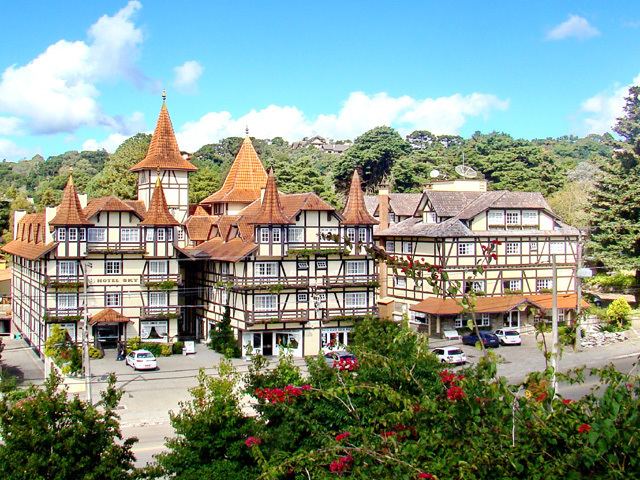Incorporated December 15, 1954 Area 237 km² Local time Saturday 12:02 AM | Elevation 850 m (2,790 ft) Population 31,655 (2007) | |
 | ||
Weather 11°C, Wind SE at 5 km/h, 92% Humidity Points of interest Lago Negro, Mini Mundo, Aldeia do Papai Noel, Rua Coberta, Le Jardin Parque de Lavanda | ||
Gramado is a municipality and small tourist town, southeast of Caxias do Sul and east of Nova Petrópolis in the southern Brazilian state of Rio Grande do Sul, in the Serra Gaúcha region. The town was originally settled by Azorean descendants and later received a contingent of German and Italian immigrants. Gramado is one of the towns along the scenic route known as Rota Romântica (Romantic Route).
Contents
- Map of Gramado RS Brazil
- Gramado day trip of gluttony travel deeper brazil ep 6
- History
- Politics and Government
- Executive Branch
- Geography
- Open spaces
- Lago Negro
- Climate
- Culture and tourism
- Sister cities
- References
Map of Gramado, RS, Brazil
Gramado day trip of gluttony travel deeper brazil ep 6
History
Gramado was originally settled in 1875 by Portuguese immigrants. Five years later, the first German immigrants arrived and these were followed shortly after by Italian immigrants from the Italian settlements in Caxias do Sul.
In 1913, the town seat was moved to Linha Nova, the location of the present-day town center. At this time, Gramado was an unincorporated township within the municipality of Taquara. A railway, brought by Gramado's founder and first administrator, José Nicoletti Filho, arrived in the city in 1921, boosting the local economy. Gramado officially became a village in 1937, when Gramado was already known as a summer holiday resort. Gramado became a municipality on December 15, 1954 by force of State Act 2,522.
Politics and Government
Gramado Government is in a strong mayor-council government model, as set forth by the Brazilian Constitution of 1988. Elections for both mayoral and legislative offices are held every fourth year. The Mayor may seek reelection once, while Councilmen have no restriction on terms they may serve.
Executive Branch
Executive powers are held by the Mayor of Gramado, who appoints a Cabinet, the heads of several municipal bodies and members of the Planning Commission. The current Mayor is Nestor Tissot (PP) elected in 2008. The current Deputy Mayor is Luia Barbacovi. In the election of 2016 the opposition candidate won, thereby Fedoca Bertolucci takes the City Hall on January 1, 2017.
Geography
The city is in a mountain range, averaging 850 meters above sea level.
Open spaces
Gramado has several green areas, the most important are Black Lake, Communications Square, Knorr Park, Orchard Park, Major Nicoletti Square and, Roses Square.
Lago Negro
Lago Negro (Black Lake) is the most known, visited green area of Gramado. It was created in 1953 by Leopoldo Rosenfeld on an area it was the biggest woods of the Hydrangeas' Region, this very area had been destroyed by fire in 1942. It was named after Good Rest Valley (Vale do Bom Retiro) before fire.
A creek was dammed up to create a U-shaped lake. Rosenfeld imported pine seedlings from Black Forest in Germany to be planted all around the newly formed lake's rim.
Lago Negro is a mile away from Town Hall. There is a boathouse, working daily from 8:30 AM to 7:00 PM, concession stands and a small craftsmen fair nearby.
Climate
The climate is maritime temperate with mild summer (Cfb, according to the Köppen climate classification). The summers are not hot, with temperatures that commonly do not exceed 30 °C (86 °F). Winters are cold, and temperatures fall below 0 °C (32 °F) sometimes, with relatively frequent frosts and uncommon snowfalls.
Culture and tourism
Sister cities
Gramado has 5 sister cities
